#babyrousa babyrussa
Explore tagged Tumblr posts
Text

Shouts the the Buru babirusa, whose scientific name is two distinct misspellings of babirusa
5 notes
·
View notes
Photo

Babirusas (Babyrousa babyrussa)
197 notes
·
View notes
Photo

Buru babirusa (Babyrousa babyrussa)
Photo by Colin Groves
#buru babirusa#moluccan babirusa#golden babirusa#hairy babirusa#babirusa#babyrousa babyrussa#babyrousa#suini#suidae#suina#artiofabula#artiodactyla#euungulata#scrotifera#laurasiatheria#boreoeutheria#eutheria#mammalia#tetrapoda#vertebrata#chordata#dead specimen
7 notes
·
View notes
Photo
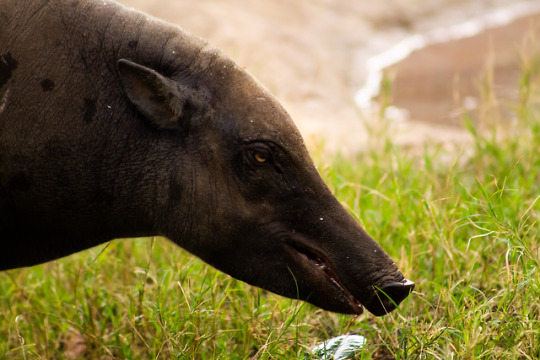
Babirusa (Babyrousa babyrussa celebensis)
taken at the LA zoo in Los Angeles, California
status: vulnerable
I have a really hard time getting a decent photo of these guys, glad to have gotten one of a female this time. Maybe the male next time!
#Babirusa#Babyrousa babyrussa celebensis#swine#animal#wildlife#photo#photography#la zoo#los angeles zoo#canon rebel t3#lightroom#adobe lightroom
1K notes
·
View notes
Text
Animal of the Day!
Buru Babirusa (Babyrousa babyrussa)

(Photo by Michael Shehan Obeysekera)
Conservation Status- Vulnerable
Habitat- Indonesia Islands
Size (Weight/Length)- 72.5 kg; 94 cm
Diet- Leaves; Fruits; Nuts; Mushrooms; Insects; Small mammals; Fish
Cool Facts- Buru babirusa are one of the subspecies of several types of babirusa. Similar in appearance to pigs, their standout feature is their tusks, of which they have four. Their tusks grow from both their bottom jaw and top jaw, but the ones on the top jaw grow a little differently. Instead of growing down, the teeth grow up until they poke through the snout and curl towards the eyes. The Buru babirusa use their tusks to forage for food and fight for a mate. On very, very rare occasions, these tusks may circle all the way back and into the forehead of the babirusa, piercing the skull and ultimately killing it.
Rating- 12/10 (Wicked canines, bro.)
#Animal of the day#Animals#Pigs#Mammals#Tuesday#September 14#Buru Babirusa#Science#Biology#Conservation#The more you know
53 notes
·
View notes
Photo

Beastember #4 Tusket
Tuskets are one of the most legit looking creatures in the game. Really. They are basically the Thedasian version of babirusa (Babyrousa babyrussa) and I think most of this species ecology could be applied to tuskets.
Headcanon: Their teeth do not make certain aspects of male anatomy bigger. It’s just a rumour.
52 notes
·
View notes
Photo
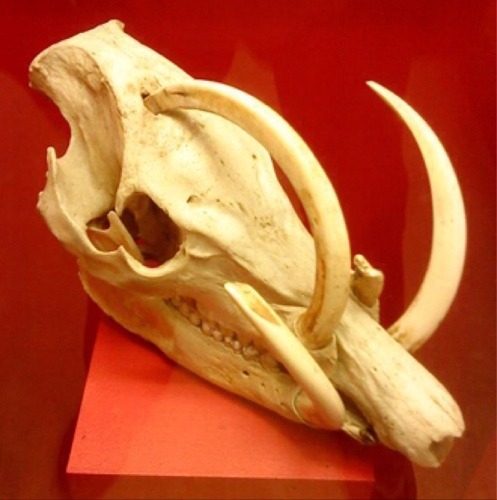
What Hath Evolution Wrought?
A babirusa is a kind of pig (known formerly as Babyrousa babyrussa celebensis). A rather strange looking pig that lives in the Indonesian islands, the babirusa has anatomical features more reminiscent of sheep (two-chambered stomachs) which suggests to biologists that the babirusa diverged early in its genetic history from the mainline of pig evolution. Another amazing feature of the babirusa is the rather strange and amazing tusks of the males. There are two lower tusks used in combat (perhaps against other pigs or to aid in plowing up dirt while looking for goodies to eat), and two further back that apparently protect their foreheads from the fighting and plowing… or possibly to merely look good for the pig-ladies.
Perhaps, these pigs took an evolutionary road going in the wrong direction. The rear tusks never stop growing, and as they lengthen they curve into the most marvelous shapes, until… yes, until they actually curve into and begin to impale their own skulls. Ouch!
Annie R
Photo supplied to TetZoo by Henrik Petersson. Read the TetZoo blog at: http://scienceblogs.com/tetrapodzoology/2010/03/08/babirusa-impales-own-head/ Other fun sources: http://www.lazoo.org/animals/mammals/babirusa/ http://www.wired.com/2014/05/the-creature-feature-10-fun-facts-about-the-babirusa/
184 notes
·
View notes
Text
Hi so, I hate to be annoying, but this post is (very slightly) related to a field of study I'm deeply interested in, and I noticed that the Irish elk info was outdated, so... I decided to do some research on a Tumblr post.
First things first, my field of research is related to extinct animals, not extant ones, so this first bit will be less in depth than the part about the Irish elk. However, doing some zooming in reveals that those "boar" (not a boar) skulls belong to Babyrousa babyrussa, commonly known as the Buru babirusa.
There's next to no mention from a quick look-through of some sites about the Buru babirusa's tusks being able to grow through its skull, thus killing it. But that image had to come from somewhere, right?
While it's nowhere close to being a common ocurrence, it is possible for a Buru babirusa to become old enough for its tusks to grow back into its skull, provided they grow a certain way. I believe that the origin of that image is this article posted on the 8th of March, 2010. Although the images no longer load, the description appears to be accurate.
This article also makes it apparent that I am at least somewhat correct in assuming that this is by no means a common ocurrence, and in addition, that the specimen that had its tusks grow through its skull must have been extremely old for this to happen. Most Buru babirusa would likely die of old age or other circumstances before ever reaching this point.
I also was unable to find anything about female Buru babirusa finding longer tusks to be a more desirable trait in a mating partner. From my understanding, swine (of which babirusa are a part of) use tusks for fighting, not mating purposes. However, again, I am not a biologist.
The theory that Irish elk went extinct as a result of the large antlers that males possessed is widely seen as outdated and inaccurate according to modern understandings. It is believed that they first evolved ~450k years ago, and that they went extinct ~7.7k years ago. That's over 100k more years than our species has been around for!
According to this paper published by C. O. Worman and T. Kimbrell, antler size actually decreased through the Late Pleistocene and into the Holocene (the current era). While a large and healthy stag could grow antlers up to 3.65m (12ft) from tip to tip, which would have weighed 40kg (88lbs), that same stag would have had antlers only weighing 20 to 28kg (44 to 62 lbs) under poor conditions, assuming they endured a similar response to starvation as a red deer.
As there was a reduction in forest density during the Late Pleistocene, as well as insufficient high-quality forage, it can be inferred that Irish Elk stags actually experienced a reduction in both body and antler size, as opposed to the growth that would have occurred as a result of "sexual selection".
(Sexual selection, by the way, is when a species breeds itself out of existence as a result of highly desired traits that end up harming its survival overtime, to massively simplify it.)
Had the Irish elk truly gone extinct as a result of the size of the stags' antlers, they would not have survived for as long as they had; rather, it is more likely they would have gone extinct during the Last Glacial Maximum (or Ice Age) as a result of how taxing their antlers are nutritionally, if they did not go extinct earlier.
Instead, what we see is far less remains known during that time period, before a substantial increase after the Earth warmed back up. It even managed to re-colonise its former range, with many remains found in Ireland, the UK, and Germany (despite its name, the Irish elk was not solely found in Ireland!)
It is not known how exactly the Irish elk went extinct, although it is theorised to be either habitat changes as a result of the changing climate, hunting by humans, or a combination of the two. In this paper on the extinction of the Irish elk, A. M. Lister and A. J. Stuart conclude that environmental factors reduced the elk to a highly vulnerable state, to the point where even low-level hunting by small human populations could have contributed to its extinction.
Also, it turns out that the Irish elk looks far less ridiculous when you don't use a skeleton to show off the size of its antlers. Here's a modern life restoration for comparison, as well as a cave painting from Lascaux from around 15,000 BC.
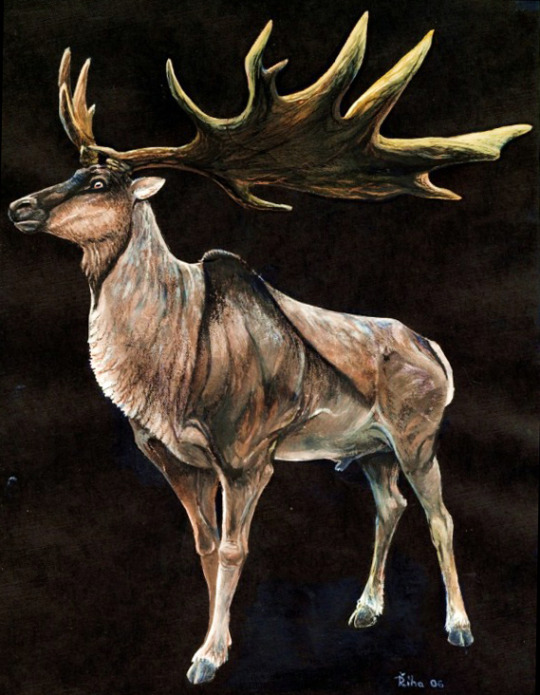

too many people see evolution as just animals becoming better animals when the truth is that theres a species of boar that evolved to die because its tusks grow into its skull because the males with long tusks fuck the most
160K notes
·
View notes
Photo
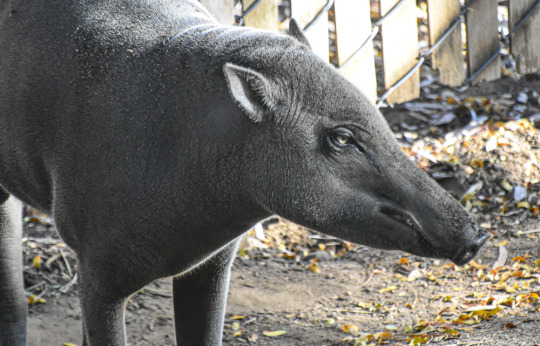
BABIRUSA Babyrousa babyrussa celebensis Los Angeles Zoo and Botanical Gardens Los Angeles, California ©Laura Quick
Babirusa is a wild pig native to the Indonesian archipelago. This is a female - the male babirusa are known for their bizarre tusks (see them here and a video here), which, if they’re not worn down or broken in combat, will eventually grow long enough to pierce the animal’s skull. Prehistoric paintings of babirusa found in caves on the island of Sulawesi in Indonesia have been dated back at least 35,400 years (to the ice age Pleistocene epoch).
Other posts you might like:
South American Tapir (baby)
Mangalitza - Curly Coated Pig
Malayan Tapir with Black Swan
#babirusa#babyrousababyrussacelebensis#indonesia#southeast asia#pig deer#wild pig#los angeles zoo#los angeles zoo and botanical garden#©laura quick#docent class#pretty eyes#mammalia#sparse hair#weird bristly skin#omnivore
4 notes
·
View notes
Photo
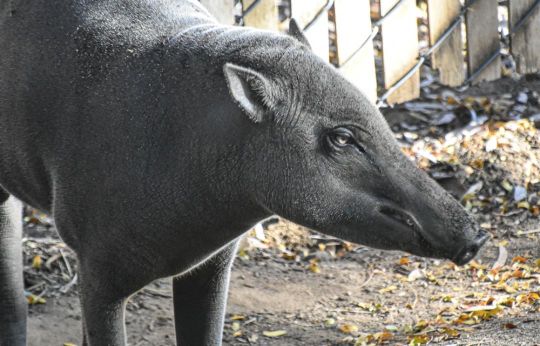
BABIRUSA Babyrousa babyrussa celebensis Los Angeles Zoo and Botanical Gardens Babirusa is a wild pig native to the Indonesian archipelago. This is a female - the male babirusa are known for their bizarre tusks, which, if they're not worn down or broken in combat, will eventually grow long enough to pierce the animal's skull. Prehistoric paintings of babirusa found in caves on the island of Sulawesi in Indonesia have been dated back at least 35,400 years (to the ice age Pleistocene epoch). #babirusa #omnivore #babyrousababyrussacelebensis #pigdeer #wildpig #losangeleszooandbotanicalgardens #losangeleszoo #lazoo #lauraquick #mammalia #prettyeyes #weirdbristlyskin #sparsehair https://www.instagram.com/p/B4I54cIHjoC/?igshid=1286e98dbbimc
#babirusa#omnivore#babyrousababyrussacelebensis#pigdeer#wildpig#losangeleszooandbotanicalgardens#losangeleszoo#lazoo#lauraquick#mammalia#prettyeyes#weirdbristlyskin#sparsehair
3 notes
·
View notes
Text
Animales exóticos increíbles que no sabías que existían
http://megusta.click/wow/animales-exoticos-increibles-no-sabias-existian/
Animales exóticos increíbles que no sabías que existían
http://megusta.click/wow/animales-exoticos-increibles-no-sabias-existian/
1. Cangrejo araña gigante japonés (Macrocheira kaempferi) 2. Ciervo de copete o eláfodo (Elaphodus cephalophus) 3. Pulpo Dumbo (Grimpoteuthis) 4. Gerenuc, gacela jirafa o gacela de Waller (Litocranius walleri) 5. Babirusa (Babyrousa babyrussa) 6. Fosa (Cryptoprocta ferox) 7. Jerbo de Gobi...
#2016#Animales#Babyrousa babyrussa#Balaeniceps rex#Cangrejo Yeti#caniche#copyright#Cryptoprocta ferox#DE LA#diario#Dolichotis patagonum#Elaphodus cephalophus#Este#Estos#Euspinolia militaris#Existían.#Extraño.#Extraños#Favor#Galeopterus variegatus#Gigante#gigante japonés#Glaucus atlanticus#Hemicentetes semispinosus#hormiga#hormiga panda#La Tierra#labios#Lobo#Macrocheira kaempferi
0 notes
Photo

Babirusas (Babyrousa babyrussa)
127 notes
·
View notes
Photo


Buru babirusa (Babyrousa babyrussa)
Photos by Klaus Rassinger and Gerhard Cammerer
#stock#buru babirusa#moluccan babirusa#golden babirusa#hairy babirusa#babirusa#babyrousa babyrussa#babyrousa#suini#suidae#suina#artiofabula#artiodactyla#euungulata#scrotifera#laurasiatheria#boreoeutheria#eutheria#dead specimen
3 notes
·
View notes
Text
babirusa babyrousa babyrussa
El babirusa (Babyrousa babyrussa) es una especie de mamífero artiodáctilo de la familia Suidae. Es un extraño cerdo nativo de las islas Célebes, en el centro de Indonesia. Su nombre proviene del malayo båbí rûsa, que significa “puerco ciervo”. Este apelativo se debe a que en el babirusa, los colmillos superiores se curvan hacia arriba de forma tan cerrada que acaban perforando la carne del morro…
View On WordPress
0 notes
Photo

Babyrousa babyrussa
The skull of the Babirussa along with the important teeth of the lower jaw in order to be compare with its relative found by Clement Van Burden, also in the Jungles of Vietnam. The Sus Cofra Satanae or Satanic Boar as Clement decided to named after studied its destructive behavior.
Follow Clement Van Burden’s Project here
#animals#wild animals#wildlife#Illustration#scientific illustration#Book Illustration#drawing#drawing animals#bio illustration#graphitedrawing#boar#wild boar#babirussa#biodiversity#mammal#artists on tumblr#illustration art#book art
250 notes
·
View notes
Text
Buru Babirusa
Babyrousa babyrussa
Both Babyrousa and babyrussa refer to babirusa, which is Indonesian for pig-deer.
Family: Suidae (Pig Family)
Fun Fact: "They are swift runners, and often swim in the sea to reach offshore islands." (ADW)
Habitat: They are endemic to rainforests of Buru, Indonesia.
Ecosystem Role: They eat fruit, fungus, and leaves of plants (acting as seed and possibly spore dispersers).
Conservation Status: Vulnerable
1 note
·
View note